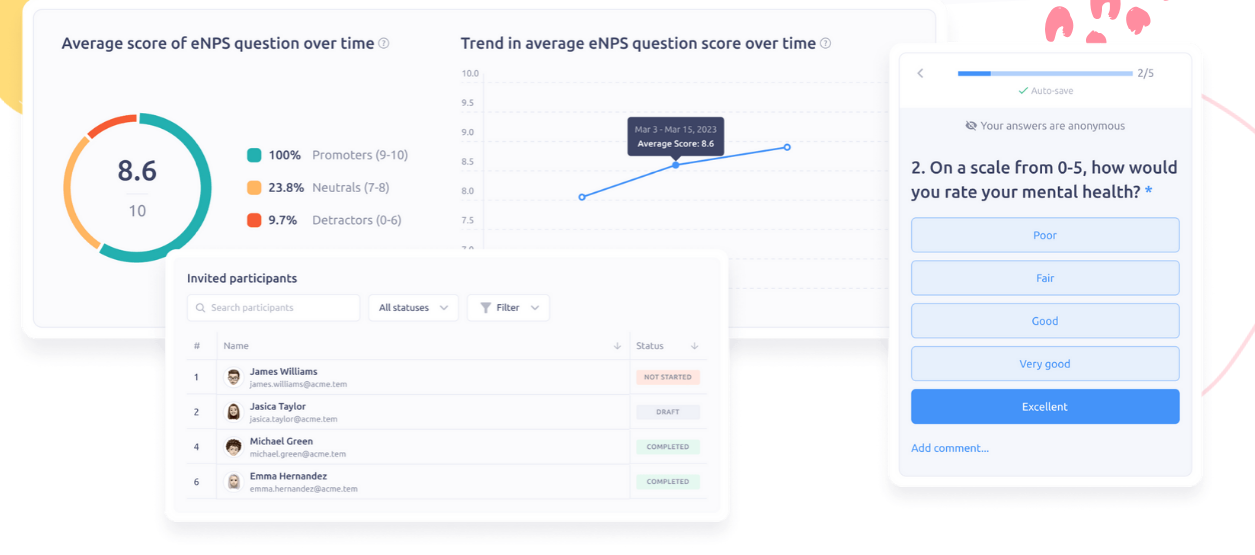
A comprehensive work-life balance survey works as a compass, guiding HR professionals and leaders in creating a workplace culture that values the well-being of its workforce.
In this article, we present a step-by-step guide to conducting a work-life balance survey, complete with a carefully curated set of questions and a template to help you get started. Let’s dive in.
Prioritizing employee well-being can result in higher job satisfaction, increased productivity, and improved employee retention rates. Here's a list of exemplary questions you can use when you create the next employee satisfaction survey concerning work-life balance:
One of the crucial aspects of creating a balance between employees' professional and personal lives is considering the workload and job demands they have to face. Here are a few questions you could use:

Another critical aspect of improving work-life balance is avoiding employee burnout and helping employees understand how to manage their time more effectively. Here's a list of questions to learn how employees feel about their time management abilities:
Lack of autonomy to organize one's work can have a negative effect on the person's work-life balance. Here's a list of questions to detect whether employees are experiencing flexibility and autonomy in their professional lives:
Good work-life integration means more balance in employees' professional and personal routines. You can learn how they feel in this respect by asking such questions as:
Creating a good work-life balance means taking care of the work environment. When its healthy, it can increase employees' overall happiness. Here are some question suggestions:
Questions about well-being constitute another vital element of a work-life balance employee survey. Here are some examples:
Initiatives aiming at achieving better work-life balance by employees are an essential part of a healthy workplace. Here's how you can ask about employee awareness of such initiatives:
Start by clarifying the overall purpose of your survey. What specific information or insights do you hope to gather? Think of the key areas or aspects you want to understand or measure.
Google Forms is a popular solution for creating surveys, questionnaires, and other forms. However, it has limited design customization options, and the available templates are very basic.

If you want a tool that will allow you to create and schedule employee surveys easily, try Plai, our performance management software. It has a feature that enables you to create and distribute a work-life balance survey to gather employee feedback on their experiences, challenges, and suggestions related to work-life balance.
Plai allows you to:

Easily schedule the survey: Effortlessly schedule and remodel recurring surveys, seamlessly incorporating new participants, modifying questions as needed, and automatically adjusting participant roles to match your team configuration.

Analyze the results: Plai's comprehensive survey analytics allow you to monitor selected metrics such as eNPS (Employee Net Promoter Score) and identify behavioral patterns and trends over a period of time.
Set goals that employees can actively pursue to achieve a healthy work-life balance. With Plai, you can set objectives for employees that prioritize their well-being, personal growth, and quality time outside of work.

Use performance reviews and one-on-ones to discuss current work-life balance with your employees. Engage in collaborative agenda creation, keep track of meeting notes, and manage action items effectively.
Choose straightforward, unambiguous questions that effectively capture the desired information. You should also ensure the survey is conducted legally, ethically, and sensitively.
If you have any doubts, consult a qualified healthcare professional or legal advisor for guidance and assistance.
If required, seek permission from relevant authorities or stakeholders before distributing the survey, especially if it involves sensitive health-related data. Utilize email lists, social media channels, or dedicated survey platforms to reach your audience.
Compile the survey responses into a structured format, such as a spreadsheet, with each row representing a respondent and each column representing a question. Check for any errors or inconsistencies in the data. Remove duplicate entries, check for missing values, and ensure all responses have correct categories.

Plai makes analyzing survey results a lot easier. It provides valuable tools to assess the linear scale and eNPS questions over multiple survey rounds, including heatmap, participation rate reporting, and trends analysis. The user-friendly filter enables the customization of data views by:
After you understand the well-being of employees and identify areas that require improvement, it is essential to take meaningful actions based on the survey results.
Plai can be very helpful here. It allows you to:
Below is a template for a work-life balance survey. Feel free to customize it based on the needs and goals of your organization:
Work-Life Balance Survey
1. Workload and Responsibilities:
a. How would you rate your current workload and job responsibilities?
b. Do you feel comfortable discussing workload concerns with your manager or supervisor?
2. Flexibility and Work Arrangements:
a. Are flexible work arrangements (e.g., telecommuting, flexible hours) available to you?
b. If you use flexible work arrangements, how satisfied are you with their effectiveness in achieving work-life balance?
3. Stress and Well-Being:
a. On a scale of 1 to 10, how would you rate your stress levels at work?
- 1 (very low stress) to 10 (very high stress)
1 | 2 | 3 | 4 | 5 | 6 | 7 | 8 | 9 | 10
b. Are there any specific work-related factors that contribute to your stress levels?
……………………………………………………………………………………………..
c. How well do you think the organization supports employee well-being?
4. Personal Commitments and Time Management:
a.How often do you find managing personal commitments and work responsibilities challenging?
b. Do you feel comfortable discussing personal commitments and time management with your manager or supervisor?
5. Work-Life Balance Support:
a. Are you aware of the work-life balance policies and resources provided by the organization?
b. How effective do you find these work-life balance policies and resources?
By investing the time and effort to design a well-crafted survey, you demonstrate your organization's commitment to prioritizing the well-being of your workforce. So, take that first step now – sign up for Plai, launch your work-life balance survey and set the wheels of positive change in motion.
In this guide, you will find:
- OKR principles
- Formulas & scores
- OKR methodology
- Step-by-step guide
- Free OKR templates
- Common mistakes
Unlimited freemium for 14 days. Easy set up. No credit card required. 99% in customer satisfaction from G2 users.




Explore our comprehensive guide on the top 8 performance management software and find the tools offering the best route toward higher employee productivity.